Fridges and freezers
Last updated: 9 August 2023

If replacing a fridge or freezer, newer models should be more energy efficient and easier on the environment.
Choosing a fridge or freezer
Fridges and freezers use about 10 per cent of an average household's electricity bill and an old fridge can cost two to three times more to run than newer, more efficient models.
You can cut down on operating costs by choosing the right fridge for your needs with a good energy efficiency rating (Energy efficiency ratings).
Energy rating labels on the Gen Less website has more information.
Things to consider include:
- Size – choose a fridge or freezer that is the right size for your household. It's more efficient to run one large fridge than two small ones, but it's inefficient to run a fridge that's far bigger than you need.
- Shape – chest freezers are more efficient than upright models. With an upright freezer, much of the cold air escapes every time you open the door. Upright freezers are a good compromise if they have:
- enclosed drawers (not baskets)
- one door above the other, rather than side-by-side doors.
- Water and ice dispensers – through-the-door features, such as cold water dispensers and ice-makers, use more energy and cost more to run.
Appliance running cost calculator
The running cost calculator allows you to find out how the energy rating affects the amount of energy used for a large range of household appliances, and how much each appliance will cost per year to run.
Refrigerants
When you buy a fridge or freezer, find out which refrigerant it uses. All models have this information inside the cabinet, on the fridge specification plate.
Some refrigerants, such as chlorofluorocarbons (CFCs) and hydrochlorofluorocarbons (HCFC), have been phased out as they deplete the ozone layer and also contribute to global warming if they leak.
Fridges now commonly use R134a refrigerant, which does not damage the ozone layer but does contribute to the greenhouse effect. A more environmentally friendly alternative, R600a, is increasingly being used by manufacturers.
Energy efficiency tips on fridges and freezers
Fridges and freezers use more power in a year than many other home appliances as they run 24 hours a day, 7 days a week.
You can cut down on operating costs by:
- putting the fridge or freezer in a cool spot, out of direct sunlight and away from ovens and cooktops, heaters and dishwashers
- ensuring there is an air gap of at least 75mm around all sides of the fridge and that air behind the fridge can enter at the bottom and escape at the top – badly vented fridges use a lot more energy
- setting the fridge thermostat to between 3°C and 5°C, and the freezer between -15°C and -18°C (every degree lower requires more energy)
- keeping some free space inside the fridge for cool air to circulate – an overloaded fridge or freezer will have to work harder
- turning off the butter conditioner
- making sure the door seals are in good condition so warm air can't leak in
- defrosting if ice is more than 5mm thick
- getting rid of your second fridge – running a second fridge costs between $100 and $300 a year.
Disposal of fridges and freezers
The refrigerants in fridges and freezers are harmful to the environment, if they escape.
If you trade in your old fridge or freezer for a new one, the delivery people will often take your old one away for you. Alternatively, take it to the landfill and leave it with other fridges so that the refrigerants can be disposed of safely by people who are experienced at doing this. There may be a cost for doing either of these.